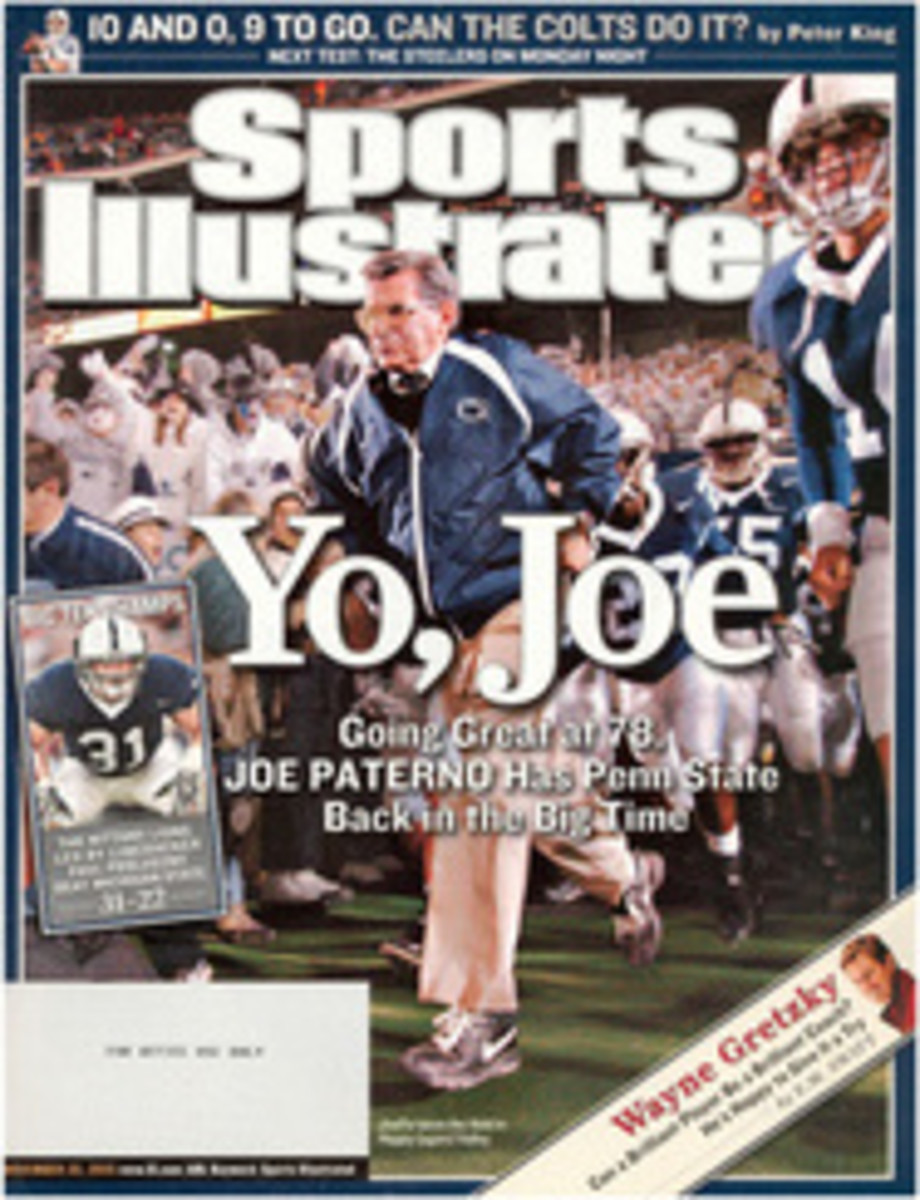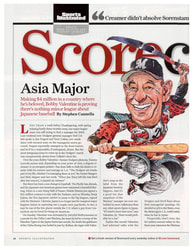
Eyewitness
To other photographers, especially those jaundiced old warriors from the newspaper ranks, it was as if he were a Martian. Who was he? Where did he come from? And: How did he do it? Neil Leifer had finagled photo assignments from SI when he was only a 17-year-old delivery boy, and by the early 1960s, barely into his 20s, he had become the magazine's most prolific shooter. Short, redheaded and young for his age in every way except when he pointed a camera, he looked like somebody who hung out with Archie and Jughead in the funny books. But he was indefatigable and creative, absolutely the real deal. In 1978 he went to work for Time magazine, but when he turned 62 last December, Leifer asked if he could come back and troop the colors one more time for SI. So off he headed to try to show with his camera what was new in our games and athletes and sporting culture.
The World Series
LOS ANGELES, HOUSTON
In 1963 Leifer caught the usually phlegmatic Sandy Koufax celebrating at the moment the Dodgers completed their sweep of the Yankees (left) in Los Angeles. At the fourth game of this year's Series, in Houston, Leifer positioned himself in hopes of getting the same sort of shot should there be another sweep, and sure enough, Bobby Jenks of the White Sox cooperated (opposite). Notwithstanding free agency, multimillion-dollar salaries, playoffs, drug suspensions and the end of daytime World Series games, baseball can retain its lovely rhymes and joyous rhythms.
Home Openers
WASHINGTON, D.C.
Following tradition, President John F. Kennedy (with Vice President Lyndon Johnson) threw the first pitch on Opening Day in Washington in 1961. Last April, when baseball returned to the capital after 34 years, George W. Bush--a former team owner who once aspired to be baseball commissioner--did the honors, and chatted with Nationals manager Frank Robinson.
Spring Training
FORT LAUDERDALE, TAMPA
Before SI there was Sport magazine, a monthly known in part for the work of Ozzie Sweet, whose classic posed photographs are as timeless as ever. "Ozzie re-created double plays--Jackie Robinson jumping over the sliding runner--always lit perfectly," Leifer says. So this spring training he decided to shoot Sweet shooting the Yankees, just as Leifer caught a newsreel photographer capturing Joe DiMaggio in 1967 (left). "All the Yankees loved Ozzie," says Leifer, who photographed Sweet photographing shortstop Derek Jeter and manager Joe Torre (above). They still do.
The Majors
AUGUSTA, ST. ANDREWS
This was The Birdie, redux. Leifer set up at the par-3 16th hole at the Masters this year to shoot Tiger Woods striding across the green in the golden afternoon light. Woods crossed him up, though, by holing out from off the green. After Leifer snapped Woods and his caddie exulting (opposite), he remembered that he'd taken an almost identical SI cover shot of Jack Nicklaus and his caddie after the Golden Bear holed out from virtually the same spot in 1972 (right). Leifer later got Tiger and Jack in duplicate at St. Andrews during the 2005 British Open (below), Nicklaus's farewell tournament.
Giants of the Hardwood
PHILADELPHIA, MIAMI
Of all the team sports, basketball is the most intimate. Vivid action shots by SI photographers helped the struggling NBA turn its stars into distinct personalities. The classic matchup was in the pivot: Wilt Chamberlain versus Bill Russell. Leifer photographed this legendary pair of giants in a 1966 76ers-Celtics playoff game at Convention Hall in Philadelphia (above). "So this year I wanted to do Shaquille O'Neal," Leifer says, "and I was impressed by how much more physical the game is. Back then they weren't leaning on each other all game. But Shaq has three people on him, pushing him in all directions." The picture at right shows the Heat center manhandling the Pistons' Ben Wallace in the 2005 Eastern Conference finals in Miami.
The Fighting Alis
NEW YORK CITY, WASHINGTON, D.C.
The first championship bout that Leifer shot was Floyd Patterson versus Ingemar Johansson, in 1959, when the 16-year-old photographer pointed his camera down from a $5 seat in the upper deck of Yankee Stadium. Only six years later he would take the most famous boxing photo ever: Muhammad Ali standing over the vanquished Sonny Liston. The shot above captures Ali at the height of his powers, whipping Zora Folley at Madison Square Garden in 1967. As the once regal heavyweight division has descended into insignificance and ennui, women boxers--especially Ali's daughter Laila (left)--have muscled in on the ring spotlight.
Grand Slams
NEW YORK CITY, LONDON
Few sports have metamorphosed as much as tennis. In 1963 the U.S. Open-to-be was merely the U.S. Championships. Only the little horseshoe stadium in Forest Hills was open. Grand Slam events excluded pros--and included few African-Americans. Now Open finals are played at Flushing Meadows in a massive hippodrome (above) named for Arthur Ashe. The court where Maria Bueno beat Margaret Smith for the '63 title (right) was of God's green grass. The one in Ashe is of blue synthetic. Of course, one thing never changes (opposite, below): Wimbledon white.
Super Bowls
LOS ANGELES, JACKSONVILLE
The first Super Bowl, concluding the peace treaty between the NFL and the AFL, was not a success. The older league's champions, the Green Bay Packers, were assumed--correctly--to be so superior to the Kansas City Chiefs that the 1967 game would not be much of a contest. Commissioner Pete Rozelle had decided to play the Super Bowl at a warm-weather neutral site, so there were no home-team fans, and the jet-setters didn't even think about jetting in. The L.A. Coliseum was not close to being sold out. The contrast between Leifer's simple long shot of the first Super Bowl's intimate pregame tête-à-tête (top) and his photo of this year's midfield mob (above) underlines the changes in not only the Super Bowl but the NFL as well.
College Football
DALLAS
At the Texas-Oklahoma game in 1963, Leifer took a sideline shot of coach Darrell Royal and his Longhorns (left)--but, of course, only the photo was black-and-white. In the 42 years since then perhaps nothing has changed so much in the college game as the racial makeup of teams, especially in the South and the Southwest. A shot Leifer made last month at the 2005 Texas-Oklahoma game (above) shows the Longhorns' African-American quarterback, Vince Young (10). One sight is still missing, however, on the football sidelines at all but three major schools: a black head coach.
Kentucky Derby
CHURCHILL DOWNS
The first time Leifer saw the fabled spires at Churchill Downs, he was surprised that they really weren't very large. They were just magnificently placed. His photo of the 1965 Derby (left) shows the spires standing tall against the bluegrass sky, a pair of gracious sentinels watching o'er the start of Lucky Debonair's race. But by this year the beautiful spires had been pinched by phalanxes of luxury boxes--that bountiful box-office innovation in most every sport that has made our stadiums and arenas less a shared community than a stratified society. This year Leifer showed in a single picture (above) how commerce has trumped perhaps the most famous architectural signature in American sport.
Auto Racing
INDIANAPOLIS,
DAYTONA
The most unpleasant venue for photographers in sportsdom, Leifer believes, is the Brickyard, for its ear-shattering noise. He can take consolation, then, in the fact that the only real sea change in major American sports has taken place in automobile racing, where the Indianapolis 500 (above, in 1962) has been replaced in esteem by the Daytona 500. When Leifer started shooting, Indy cars owned U.S. racing, while NASCAR was a regional sideshow, dismissed in sophisticated sports circles as a hillbilly carousel. Since then NASCAR has grown to be generally accepted as the fourth major American sport, after football, baseball and basketball. Of course, as Leifer found this year on his first trip to Daytona (left), auto racing by any name is still noisy.
SI.COM
See more photos from Neil Leifer's 2005 odyssey at SI.com/leiferpix.
 
PHOTO
PHOTOGRAPHS BY NEIL LEIFER
Leifer at 18 in Cleveland Municipal Stadium (right) and at 62 at the Kentucky Derby (bottom), adding his own branch to a camera tree.
PHOTO
BILL FRAKES
Leifer at 18 in Cleveland Municipal Stadium (right) and at 62 at the Kentucky Derby (bottom), adding his own branch to a camera tree.
TWENTY FOUR PHOTOS
photographs by Neil Leifer
PHOTO
photographs by Neil Leifer
2005 VENUS WILLIAMS
PHOTO
photographs by Neil Leifer
2005 MARIA SHARAPOVA
PHOTO
photographs by Neil Leifer
1976 BJORN BORG
PHOTO
photographs by Neil Leifer
1976 CHRIS EVERT

